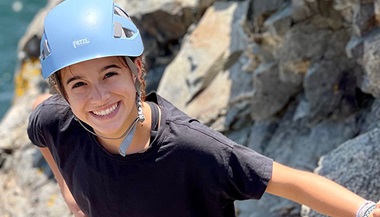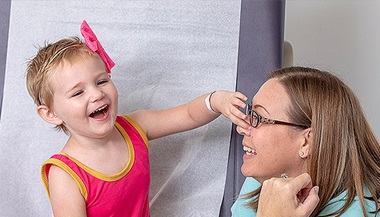Patient Story
Arthrogryposis: Lucciano's Story
Patient Story Highlights
- Lucciano was born with a multitude of medical challenges, including arthrogryposis, a disease affecting the joints and muscles.
- Lucciano's parents took the Parent Emergency Preparedness for Tracheostomy Assisted Living and Care training program to care for him.
- Johns Hopkins all Children's Hospital Center for Medical Simulation and Innovative Education teaches parents how to care for their child in high-risk scenarios.

It was the hole that got to them.
Just the idea of it.
Doctors were recommending a permanent tracheostomy tube for 4-month-old Lucciano—and his parents, Hector and Victoria, were not having it.
A hole in their baby’s throat? It just seemed unnatural, extreme—a defeat, somehow. Especially after all they had been through with their son.
Lucciano was born with a multitude of medical challenges, including arthrogryposis, a disease affecting the joints and muscles. He had had a stroke in utero and had experienced seizures. He struggled with his breathing, and required a ventilator.
In his first few months of life, spent mostly in the hospital, Lucciano had been a little warrior. He’d come a long way. But his best chance to go home safely was with a tracheostomy tube along with his ventilator.
“We fought it,” says his dad, Hector. “We hoped he would outgrow the need for it.”
This young family needed convincing. Their conversion would come in the form of a sweet-faced and highly skilled respiratory therapist who showed up one day in their hospital room. Julia Krzyzewski, R.T., had an easy manner and solid skills in the art of persuasion.
“She’ll never know what a difference she made for our son,” says Lucciano’s mom, Victoria.
The education began right away. Julia helped the parents understand how the tube would serve as a secured airway and how it could bypass a host of potential problems. She taught them how to take care of the tracheostomy site, how to change the tube, and most critically, how to trouble-shoot if something went very wrong.
“These are parents who do not have a medical background. They have to learn to do a lot of really complex things in the home environment,” Krzyzewski says.
It is an intimidating prospect for parents—how they respond to a trach emergency could mean the difference between life and death for their child.
“Your first instinct is to freak out,” Victoria says. “But you learn you don’t have time for that. You have to act.”
Victoria and Hector needed to practice. But they didn’t want to make mistakes while trying to learn on their child. Luckily, they were candidates for a remarkable training program at Johns Hopkins All Children’s Hospital, designed especially for families like theirs.
Parent Emergency Preparedness for Tracheostomy Assisted Living and Care (PEP-TALC) is a simulation training program that provides parents with “hands on” practice in realistic, high-risk scenarios. In the safe environment of the Simulation Center, Hector and Victoria could make their mistakes on a high- tech doll, instead of their child.
“It’s still nerve-racking,” Hector says. “But you just have to get those jitters out of the way …”
Practice Makes Perfect
The first six weeks are intensive for Lucciano’s mom and dad. Hector and Victoria must rehearse what they’ve learned; they must act with split-second timing. Maybe the baby has pulled his trach out, for example, or his airway is blocked. What do they do? Life-threatening scenarios.
The mannequin baby is programmed with physiological responses—all clues as to what could be going wrong. The couple might look for a chest rise, or observe whether the doll is turning blue around the mouth. They learn how to suction the baby, and how to “bag” an infant (a form of resuscitation by manually squeezing a bag of purified oxygen into the baby’s airway).
Hector and Victoria train until it is pure instinct—until muscle memory can take over wherever fear might creep in.
They learn things they never thought they could.
The day will come when it will make all the difference in the world.
Crisis at Home
It has been a hectic day.
The family has had baby Lucciano home for less than two weeks now, and he’s being treated for a respiratory infection.
On instinct, Hector decides not to go in to work. He and Victoria are sitting with their baby, watching Dora The Explorer, Lucciano’s favorite, when it happens.
Dad is holding Lucciano’s hand. Suddenly, he feels his baby squeeze his finger and not let go.
Their baby is turning red. He is not breathing.
The parents spring into action. As they go to work on Lucciano, they look to the monitor. Their child’s heart rate and oxygen levels are dropping. He is unconscious.
Victoria begins chest compressions. No response.
Hector and Victoria look at each other and instantly say the same words, “Bag him!” They begin the manual resuscitation. They manage to clear a mucus plug—the cause of this emergency. Somehow, as they work on their baby, Hector manages to call 911.
All of this happens in seconds.
Paramedics soon arrive, only to observe that these parents have everything under control. They transport the baby to Johns Hopkins All Children’s Hospital.
Lucciano’s color has come back, his vitals have improved, and he has fallen into an exhausted, but peaceful sleep.
Back in the hospital temporarily, Victoria observes her sleeping baby.
“He almost died,” says Victoria. “If it wasn’t for the simulation training we received, my baby wouldn’t be here right now.”
The grateful parents make sure they thank Julia, the respiratory therapist who helped give them the skills and confidence needed to care for their son.
“You saved our baby’s life!” Victoria says to her.
“No, I was home in my living room,” she responds. “You guys saved Lucciano.”




